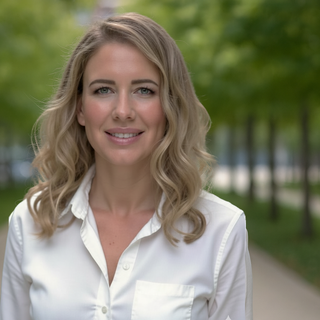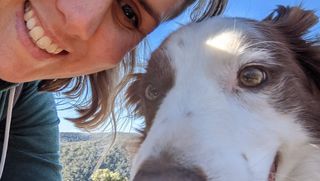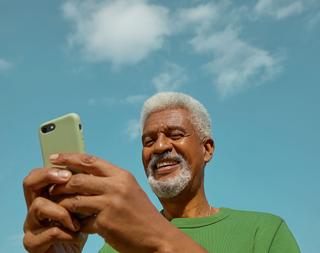Insights from an Orthoptist
An interview with orthoptist and Orientation and Mobility specialist April Harris.


Support when it matters most
As someone who’s spent nearly 20 years supporting people with low vision, April has seen firsthand how the right support, offered at the right time can help her clients reconnect with their daily routines, their confidence and joy. She knows how powerful it can be to have someone in your corner who understands vision loss and works with you to find new ways of doing the things that matter most.
As a qualified Orthoptist and experienced Orientation and Mobility Specialist at Guide Dogs NSW/ACT, April reflects on how low vision care goes far beyond clinical tools.
“I think a lot of people hesitate to seek help,” April says. “They report feeling their vision ‘isn’t bad enough’ or they don’t want to take resources away from someone who they think might ‘need it more.’ But the truth is, if your vision is affecting your day-to-day life in any way, support is available, and you deserve it.”
April’s career began in orthoptics, where she focused on helping people access print more easily - like reading mail, food labels, books, or street signs (when I started, we didn’t have the smartphones – this came later on). One approach she became passionate about is eccentric viewing, a technique that helps people with central vision loss learn to use their side vision more effectively.
“It’s not widely practiced, but it can be life-changing,” April says. “I worked with clients who were able to read everyday print again, and feeling more confident getting around. It’s incredibly empowering.”
April has worked in clinics, homes, and community settings supporting people with low vision. She knows that no two people experience vision loss in the same way, and that’s why the best support often involves more than one type of professional.
“An orthoptist might help with reading or using magnifiers. An Occupational Therapist can assist with daily tasks like making a cup of tea or using kitchen appliances. Orientation and Mobility specialists help people to move around safely and confidently, whether it’s getting to the letterbox or learning a new route to the shops”.
April has worked with hundreds of clients and says she’s still learning.
“Each person is at a different stage of their vision journey, and brings different goals or challenges to work towards," she says. "What matters is working together to find what’s going to make the biggest difference in their day-to-day life. Some clients aim to improve their reading; others want to get to their workplace safely or make a cup of tea without spilling. It’s not about how severe your vision loss is, it’s about how it’s impacting your daily life. For some people the goal might be as simple and as important as safely accessing the letter box or being able to play mahjong again."
April explains that some clients benefit from seeing multiple professionals:
- An orthoptist might help you access printed materials and help you use your remaining vision more effectively.
- An Orientation and Mobility (O&M) specialist helps with getting around safely and confidently, like using public transport or crossing a street.
- An Occupational Therapist (OT) supports activity of daily living tasks like cooking, cleaning, using devices, or managing lighting at home.
- Assistive Technology Specialists can assist with accessing information through technology.
Technology is also ever advancing in this space. It can feel daunting, especially for older clients, but April encourages people to give it a try. “It’s worth learning. There are tools on smartphones and tablets now that can help with everything from reading recipes to describing your surrounds. You don’t have to figure it out alone.”
Reaching out for help can feel hard but it’s worth it. April acknowledges that many people experience a sense of grief when their vision changes. “Some clients come to the low vision clinic with a family member who’s wanting to find help,” she says. “The client is not always ready. And that’s okay. The most important thing is knowing what support exists, so when they are ready, they know what is available to them.”
Who can access services?
You don’t need to be legally blind to get help. Help is available if your vision is making everyday tasks harder, no matter how big or small.
“One client's Orientation and Mobility goal was to walk to her letterbox alone,” April says. “That could be the goal of the program, or it could be that’s where it starts, and more goals develop when the confidence increases.”
How to Get Started
If you or a loved one are interested in seeking support to navigate permanent vision changes, contact SeeWay or Guide Dogs NSW/ACT directly by phone or via the online referral form. And if you’re unsure whether you’re eligible, April encourages a simple step: talk to someone.
“A phone call can be the first step toward regaining confidence. Even if you’re not ready to jump in yet, having the conversation can be a powerful thing."
Guide Dogs NSW/ACT provides guide dogs and a range of mobility and support services to help people with low vision or blindness live independently and safely.
SeeWay is a free national initiative by Guide Dogs NSW/ACT offering Australians with permanent vision loss access to counselling, digital literacy training, and personalised support to help them adapt and stay independent.
Your lived experience with vision changes might be exactly what someone else needs to hear. Whether it's a tip, a story or something you've experienced or learnt along the way, if you'd like to share, we'd love to listen. Write or call us at:
Did you find this article helpful?
Share your thoughts and help us make our resources better for everyone.
Enjoying the content?
Start building your profile to access personalised support, resources, and tools tailored to your eye health journey.
